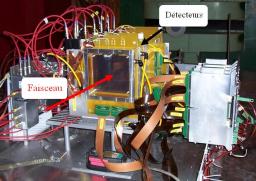A team of physicists, engineers and technicians from IRFU are developing a new generation of MicroMegas trackers. The planned Compass II experiment at CERN, together with the Clas12 experiment at the Jefferson Lab, will impose new operational constraints preventing the current generation of trackers from working with nominal performance. Tests on a new generation of detectors have been carried out using particle beams generated at CERN. These tests have achieved both of their objectives; a reduction of the discharge rate which is a limiting factor in high flux experiments such as Compass, and a demonstration of their ability to operate under intense magnetic fields, a requirement for the gas detectors of the future Clas12 spectrometer. In a wider perspective, the development of MicroMegas technology is an essential component of the current IRFU research strategy with the recent establishment of a workshop dedicated to the design of this type of detectors.
1 The aim of the RD51 collaboration is the development of micro pattern gas detectors for use in fundamental and applied research. The collaboration currently involves 73 universities and research laboratories in 25 countries..
2 The MicroMegas Research Organization (MIRO) is an organizational body established by IRFU with the aim of coordinating developments relating to micro structured gas detectors.
Contacts
Brahim MORENO (SPhN/Clas)
Stepan AUNE (SEDI)
Damien NEYRET (SPhN/Compass)
• Innovation for detection systems › Detectors for both infinite physics Structure of nuclear matter › Quarks and gluons hadron structure The ultimate constituents of matter
• The Electronics, Detectors and Computing Division • The Nuclear Physics Division
• CLAS12 • Compass : COMmon Muon Proton Apparatus For Structure and Spectroscopy




